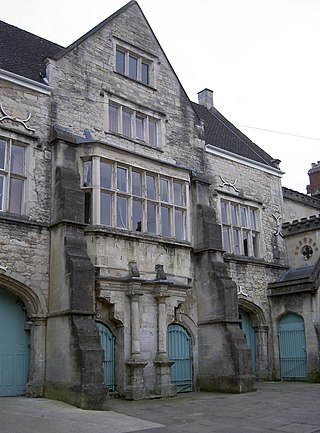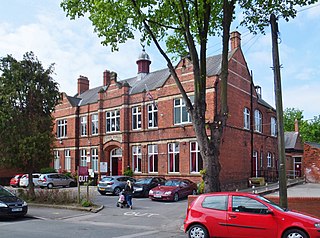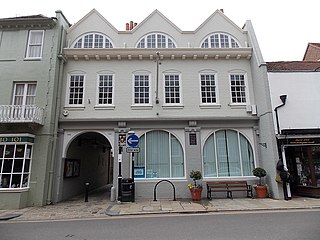
Torfaen is a county borough in the south-east of Wales. Torfaen is bordered by the county of Monmouthshire to the east, the city of Newport to the south, and the county boroughs of Caerphilly and Blaenau Gwent to the south-west and north-west. It is within the boundaries of the historic county of Monmouthshire, and between 1974 and 1996 was a district of Gwent, until it was reconstituted as a principal area in 1996.

Blaenavon is a town and community in Torfaen county borough, Wales, high on a hillside on the source of the Afon Lwyd. It is within the boundaries of the historic county of Monmouthshire and the preserved county of Gwent. The population is 6,055.

Blaenavon Industrial Landscape, in and around Blaenavon, Torfaen, Wales, was inscribed a World Heritage Site by UNESCO in 2000. The Blaenavon Ironworks, now a museum, was a major centre of iron production using locally mined or quarried iron ore, coal and limestone. Raw materials and products were transported via horse-drawn tramroads, canals and steam railways. The Landscape includes protected or listed monuments of the industrial processes, transport infrastructure, workers' housing and other aspects of early industrialisation in South Wales.

The Old Town Hall is a municipal building in The Shambles, Stroud, Gloucestershire, England. The town hall, which was the headquarters of Stroud Urban District Council, is a Grade II* listed building.

Farnham Town Hall is a municipal building in South Street, Farnham, Surrey, England. It provides the offices and the meeting place of Farnham Town Council.

Selby Town Hall is a municipal building in York Street in Selby, North Yorkshire, England. The structure, which was built as a Methodist chapel, is now the home of Selby Town Council.

Wigtown County Buildings, also known as Wigtown County Buildings and Town Hall, is a municipal building in The Square, Wigtown, Scotland. The structure primarily served as the meeting place and town hall for Wigtown Burgh Council, but was also used for some meetings of Wigtownshire County Council. It is a Category B listed building.

Hessle Town Hall is a municipal building in South Lane, Hessle, East Riding of Yorkshire, England. It is the meeting place of Hessle Town Council.

Tring Market House is a municipal building in the High Street, Tring, Hertfordshire, England. The structure, which is the meeting place of Tring Town Council, is a Grade II listed building.

Holyhead Town Hall is a municipal structure in Newry Street, Holyhead, Wales. The town hall is the meeting place of Holyhead Town Council.

Horbury Town Hall is a former municipal building in Westfield Road, Horbury, West Yorkshire, England. The structure, which is now used as business centre, is a locally listed building.

Seaton Town Hall was a municipal building in Fore Street, Seaton, Devon, England. The former Town Hall, which was the meeting place of Seaton Urban District Council, currently hosts The Gateway Theatre, providing live music, theatre, cultural and community events.

The Old Town Hall is a building on Church Street in the market town of Poulton-le-Fylde in Lancashire, England. The building, which is located just beyond the northern end of Market Place, started life as a public house before becoming a municipal building and then reverting to use as a public house.

Warsop Town Hall is a municipal building in Church Street in Warsop, Nottinghamshire, England. The building is home to Warsop Parish Council, and was formerly the offices of Warsop Urban District Council and the local offices of Nottinghamshire County Council.

The Old Town Hall, is a former municipal building in Albion Street in Southwick, West Sussex, England. The building, which is now used as offices, was the meeting place of Southwick Urban District Council.

The Council House is a former municipal building in Chester Road North, Brownhills, West Midlands, England. The building, which is now used as a health centre, is a locally listed building.

Meltham Town Hall is a municipal building in Carlile Street in Meltham, West Yorkshire, England. The building, which formerly operated as the offices of Meltham Urban District Council, is now The Crossroads Centre, which operates the local foodbank.

Llangollen Town Hall, is a municipal building in Castle Street, Llangollen, Denbighshire, Wales. The structure, which is the meeting place of Llangollen Town Council, is a Grade II listed building.

Eton Town Council Offices is a municipal building in the High Street in Eton, a town in Berkshire, in England. The building, which serves as the meeting place of Eton Town Council, is a locally listed building.

New Milton Town Hall is a municipal building in Ashley Road in New Milton, a town in Hampshire, in England. The building accommodates the offices and meeting place of New Milton Town Council.





















